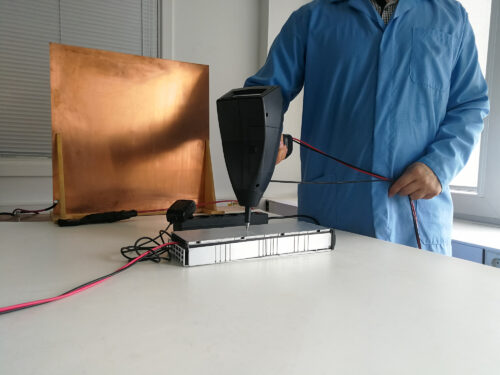What is EMI Susceptibility?

EMI/EMC susceptibility is the vulnerability of an electronic device to electromagnetic energy that can result in disruptions to that device’s normal operation. These disruptions can result in physical damage of the device, or unwanted operational events that can lead to property damage, injury, or death.
This is of special concern where safety critical devices are operated in environments that have large amount of electromagnetic interference being generated by other devices. Such product sectors include automotive, medical, aerospace, and defense. These issues are becoming more significant because of the proliferation of wireless devices and because IC with lower supply voltages have lower noise margins.
Device susceptibility is generally attributable to three sources of Electromagnetic Interference (EMI); energy that is conducted into a device from its incoming power or I/O, energy that is radiated from external sources, and Electrostatic Discharge (ESD).
Industry Standards That Address Susceptibility
U.S. Defense Standards
MIL-STD-461 is the generally applicable EMI/EMC standard for developmental test and evaluation. Test methods include Radiated Emissions, Conducted Emissions, Radiated Susceptibility, and Conducted Susceptibility. Susceptibility testing includes simulations of magnetic, radio frequency, Electrostatic Discharge (ESD), and Electromagnetic Pulse (EMP).
Standards for evaluating power related issues include MIL-STD-1275 for military vehicles. MIL-STD-704 for equipment on aircraft, and MIL-STD-1399 for shipboard equipment.
Medical Devices
Because medical devices operate in areas with many other devices, and because their function is safety critical, a number of standards are evolving to meet safety concerns. One possibility is ANSI C63.27-2017 “American National Standard for Evaluation of Wireless Coexistence”. Although its primary application is medical equipment it can be used for any wireless application. As well as addressing radiated, conducted, and power related sources of interference, the standard also establishes testing protocols for evaluating wireless coexistence.
Automotive Standards
The automotive industry generally evaluates components with standards specific to the vehicle manufacturer. Many of these test methodologies however, are derived from ISO 11452 and ISO 16750-2. For heavy equipment SAE J1455 is useful for evaluating the effects of steady state electrical power, transients, noise, ESD, and electromagnetic sources.
The Importance of Proper Testing
Properly designed products and proper testing of them is essential to ensure that electronic products operate as intended. It is important to be aware of the probable sources of EMI that will be prevalent in a products intended environment early in development. Often this information can be found in the appropriate test standard.
Understanding the relevant standard can also help in the preparation of of an overall test strategy in the early stages of product development. When preparing for testing, resources should be allotted for development of off-chamber equipment to simulate peripheral components and appropriately engage the equipment under test in a manner that will reflect performance of the product in the field.
It is also important to identify modes of operation of equipment and document any acceptable degradation of performance for those modes, thereby establishing clear pass/fail criteria.
CVG Strategy Experts
Our experts at CVG Strategy have extensive experience in Environmental/Dynamic and EMI/EMC testing for a number of industries and products, both military and commercial. CVG Strategy specializes in Independent Developmental Testing and Evaluation including development of Test Plans, Test Procedures, Test Witnessing and Troubleshooting.
CVG Strategy is a consultancy offering coaching, mentoring, training and program development focused on areas including Business Process Improvement, ITAR and Export Compliance, Cyber Security and Quality Management Systems.


